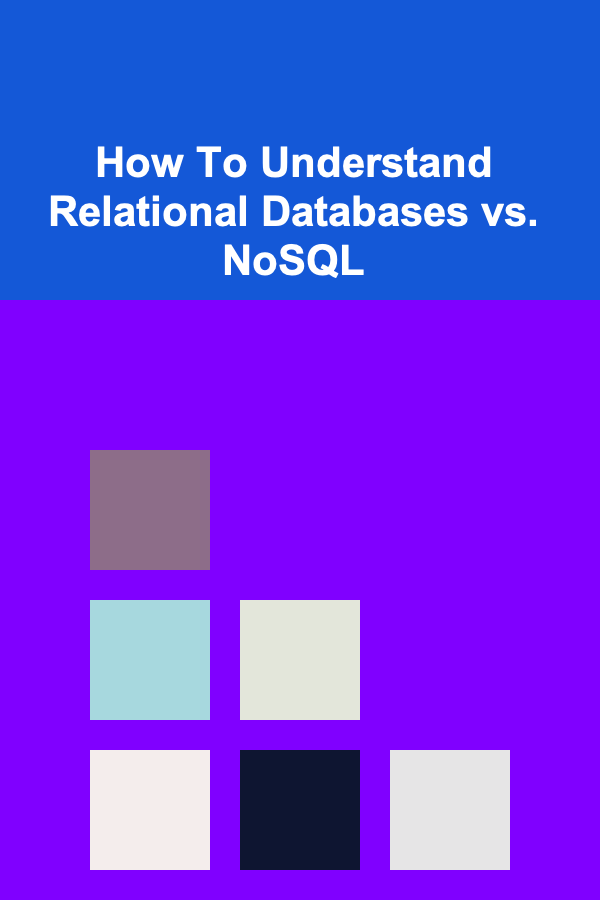
How To Understand Relational Databases vs. NoSQL
ebook include PDF & Audio bundle (Micro Guide)
$12.99$8.99
Limited Time Offer! Order within the next:

Relational Databases (RDBMS) and NoSQL databases represent two major approaches to storing, managing, and retrieving data. While they both serve the fundamental purpose of data storage, they have different architectures, use cases, and underlying principles. Understanding the distinctions between these two types of databases is crucial for anyone working in software development, data engineering, or systems architecture. In this article, we will explore the key differences, advantages, disadvantages, and appropriate use cases for both relational databases and NoSQL databases.
Introduction to Databases
Before diving into the specifics of relational and NoSQL databases, it's important to understand the basic concept of a database. A database is a structured collection of data that is stored and managed to be easily accessed, updated, and manipulated. In today's data-driven world, databases are a critical component of most software systems, from small applications to massive enterprise-level platforms.
Databases generally fall into two broad categories:
- Relational Databases (RDBMS): These databases store data in tables that are related to each other. They use structured query language (SQL) to interact with the data. Popular examples of RDBMS include MySQL, PostgreSQL, and Oracle Database.
- NoSQL Databases: These databases are non-relational and allow for a flexible data model that doesn't require a predefined schema. NoSQL databases are generally more scalable and can handle unstructured data. Popular examples of NoSQL databases include MongoDB, Cassandra, and Redis.
Relational Databases (RDBMS)
Relational databases follow a structured approach to data storage, organizing information into tables made up of rows and columns. These tables are linked together via relationships, typically represented by primary and foreign keys. The main principles of relational databases are encapsulated in what is known as the Relational Model, which was introduced by Edgar F. Codd in 1970.
Key Features of Relational Databases:
- Structured Data: Data is stored in tables with predefined schemas. Each table consists of rows (records) and columns (fields).
- ACID Compliance: Relational databases ensure that transactions are processed reliably and support ACID (Atomicity, Consistency, Isolation, Durability) properties, which guarantee data integrity even in cases of system failures.
- SQL Query Language: Relational databases use SQL (Structured Query Language) for defining, querying, and manipulating data. SQL is a standardized language that provides powerful capabilities for querying data, joining tables, and performing complex operations.
- Normalization: Data is often normalized in relational databases, which means organizing it in such a way as to reduce redundancy and dependency. This improves data consistency and reduces the potential for anomalies during updates.
- Vertical Scaling: Relational databases typically scale vertically, meaning that performance is improved by upgrading the hardware (e.g., adding more CPU, memory, or storage).
Advantages of Relational Databases:
- Data Integrity: Due to their ACID compliance, relational databases offer strong guarantees regarding data consistency, which is critical for applications such as banking and e-commerce.
- Complex Queries: SQL allows for complex querying capabilities, including joins, aggregations, and subqueries, which enable sophisticated data analysis.
- Mature Technology: Relational databases have been around for decades and have a well-established ecosystem of tools, libraries, and support communities.
- Data Consistency: With relational databases, ensuring that data remains consistent across different parts of the system is relatively straightforward.
Disadvantages of Relational Databases:
- Rigid Schema: The fixed schema in relational databases can be a limitation for applications where data structure is frequently evolving or not well-defined upfront.
- Scalability Challenges: While relational databases can handle large volumes of data, they typically struggle with horizontal scaling, especially when faced with very large amounts of unstructured or semi-structured data.
- Performance Issues with Large Datasets: Complex joins and large queries can degrade performance in large-scale systems.
Use Cases for Relational Databases:
- Financial Systems: Applications that require high levels of data integrity and transactional support, such as banking systems, benefit from relational databases.
- Enterprise Resource Planning (ERP): Many large organizations use relational databases to manage inventory, human resources, and other enterprise-level resources.
- Customer Relationship Management (CRM): Relational databases are a good fit for CRM applications, where structured customer data and relationships between different entities (like customers and orders) are crucial.
NoSQL Databases
NoSQL, short for "Not Only SQL," is a broad category of databases that emerged to address the limitations of relational databases in handling large-scale, unstructured, or rapidly changing data. NoSQL databases are designed to be flexible, scalable, and performant, especially when dealing with massive volumes of data, complex data models, or distributed systems.
Key Features of NoSQL Databases:
-
Flexible Schema: Unlike relational databases, NoSQL databases do not require a predefined schema. This allows for dynamic and flexible data structures, which are ideal for applications that evolve over time or need to store varied data types.
-
Horizontal Scalability: NoSQL databases are designed for horizontal scaling, meaning they can be distributed across multiple servers or nodes. This enables them to handle massive datasets and high-velocity transactions.
-
Eventual Consistency: NoSQL databases often focus on scalability and availability at the cost of strict consistency. They tend to prioritize availability and partition tolerance (as per the CAP theorem), offering eventual consistency rather than immediate consistency.
-
Various Data Models: NoSQL databases support multiple data models, including:
- Document-based (e.g., MongoDB)
- Key-Value (e.g., Redis)
- Column-family (e.g., Cassandra)
- Graph-based (e.g., Neo4j)
-
Optimized for Big Data: NoSQL databases are generally better suited for big data applications, offering performance improvements when processing large datasets or high-velocity data.
Advantages of NoSQL Databases:
- Scalability: NoSQL databases are optimized for horizontal scaling, meaning they can easily grow across distributed systems. This is particularly useful for applications with high traffic and large volumes of data.
- Flexibility: The flexible schema design of NoSQL databases allows developers to store data in a variety of formats, making them ideal for rapidly changing or evolving applications.
- High Availability: NoSQL databases are built to support high availability and fault tolerance, making them suitable for applications that require uptime and resiliency.
- Performance: Many NoSQL databases are optimized for fast reads and writes, and they can handle large volumes of unstructured or semi-structured data with high throughput.
Disadvantages of NoSQL Databases:
- Lack of Standardization: Unlike relational databases, NoSQL databases do not have a universal query language or standardized interface, which can make it more challenging to switch between different systems.
- Eventual Consistency: While NoSQL databases may offer high availability, they typically sacrifice consistency in favor of it, which can lead to data inconsistency in distributed environments.
- Complexity in Handling Relationships: Unlike relational databases, NoSQL databases do not have the concept of joins, making it more difficult to express complex relationships between data points.
- Lack of ACID Transactions: Many NoSQL databases do not support ACID transactions, which can lead to issues with data integrity in systems requiring strict transactional guarantees.
Use Cases for NoSQL Databases:
- Real-Time Analytics: NoSQL databases like Apache Cassandra are used in real-time analytics systems that need to process massive amounts of data with low latency.
- Content Management Systems: Applications like content management systems, e-commerce platforms, and social media sites benefit from NoSQL databases due to their flexible data models and ability to store unstructured data.
- Internet of Things (IoT): IoT applications, which generate massive volumes of diverse data, benefit from NoSQL databases due to their ability to handle large-scale, rapidly changing data from millions of devices.
- Big Data Applications: NoSQL databases are widely used in big data systems that require horizontal scaling to handle large volumes of structured, semi-structured, or unstructured data.
Relational Databases vs. NoSQL: A Comparison
While both relational and NoSQL databases have their strengths, the choice between the two depends on various factors, such as the complexity of the data, the scalability requirements, and the nature of the application. Below is a comparison of the two database types based on key factors:
1. Data Model
- Relational Databases: Data is stored in tables with predefined schemas and is highly structured.
- NoSQL Databases: Data can be stored in various formats, such as key-value pairs, documents, columns, or graphs, with flexible or no schema.
2. Scalability
- Relational Databases: Typically scale vertically (upgrading the server hardware).
- NoSQL Databases: Designed for horizontal scaling (distributing the data across multiple nodes or servers).
3. Consistency
- Relational Databases: ACID compliant, ensuring strong consistency.
- NoSQL Databases: Often offer eventual consistency, focusing on availability and partition tolerance instead of immediate consistency.
4. Query Language
- Relational Databases: Use SQL, a powerful and standardized language.
- NoSQL Databases: Have different query languages, depending on the type (e.g., MongoDB uses a query language similar to JSON).
5. Use Case Suitability
- Relational Databases: Best for applications with structured data and complex relationships, such as financial systems and enterprise applications.
- NoSQL Databases: Suitable for applications that require scalability, flexibility, and the ability to handle unstructured or semi-structured data, such as social media platforms, big data analytics, and IoT systems.
Conclusion
Understanding the key differences between relational databases and NoSQL databases is essential when choosing the right database for a specific use case. Relational databases are a tried-and-true solution for applications with structured data and complex relationships, while NoSQL databases offer flexibility, scalability, and performance for modern applications dealing with big data, unstructured data, or rapidly changing information.
Both types of databases have their unique advantages and limitations, and in many cases, a hybrid approach---using both relational and NoSQL databases---might be the best solution for a comprehensive data management strategy. Ultimately, the choice between relational and NoSQL databases should be guided by the specific needs of the application, the scale of data, and the complexity of the operations.

How to Build a Tool Shed on a Budget
Read More
How to Gather and Organize Supporting Documents for Your Grant Application
Read More
How to Handle Property Damage Caused by Tenants
Read More
How to Make a Job Interview Checklist for Handling Nerves and Stress
Read More
How to Set Up a Crafting Routine with Kids
Read More
How to Utilize Area Rugs for Defining Spaces
Read MoreOther Products

How to Build a Tool Shed on a Budget
Read More
How to Gather and Organize Supporting Documents for Your Grant Application
Read More
How to Handle Property Damage Caused by Tenants
Read More
How to Make a Job Interview Checklist for Handling Nerves and Stress
Read More
How to Set Up a Crafting Routine with Kids
Read More